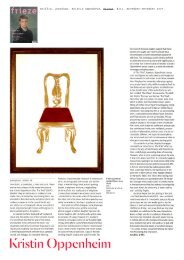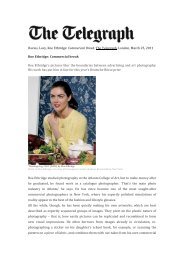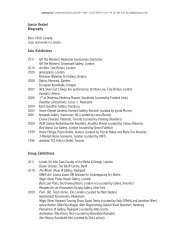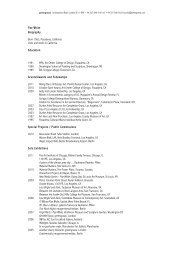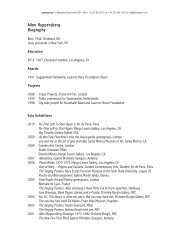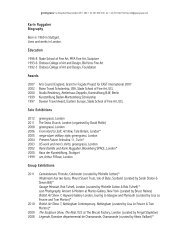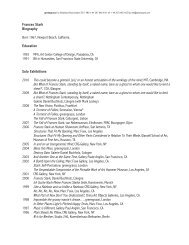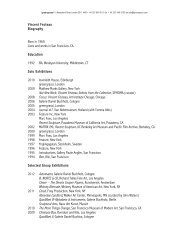Teasdale, Paul, Moyra Davey, Frieze, #44, London ... - Greengrassi
Teasdale, Paul, Moyra Davey, Frieze, #44, London ... - Greengrassi
Teasdale, Paul, Moyra Davey, Frieze, #44, London ... - Greengrassi
Create successful ePaper yourself
Turn your PDF publications into a flip-book with our unique Google optimized e-Paper software.
Mousse 26 ~ <strong>Moyra</strong> <strong>Davey</strong><br />
gigiotto del vecchio: Your work includes photography, film<br />
and video, and makes clear references to writing and to philosophy as well.<br />
Could you please tell me something about this “world of intersections” that<br />
influences your practice?<br />
moyra davey: Photography, film and video are closely related, and it’s<br />
very easy for artists to move from one to the other. When you’ve worked intensely<br />
in one medium for a while – for me it was photography for many years<br />
– it can feel invigorating to start fresh on a new project in writing and video.<br />
These days I have a few things going at once: I am reading and writing on Mary<br />
Wollstonecraft, Mary Shelley, and that whole amazing circle of women, and<br />
slowly some related photos and videos are creeping in. Probably I will hunker<br />
down and seriously begin to evolve a video out of some of this writing, but for<br />
now, it’s that very pleasurable form of “flânerie” known as research.<br />
gdv: you suggest an affinity between the acts of reading and writing,<br />
these two opposite sides of communication that intersect with each other;<br />
what exactly you mean when you say that reading and writing are complementary?<br />
Is this one of the topics in your book The Problem of Reading<br />
(Document Books, 2003)?<br />
md: Yes, it was a conclusion I came to in The Problem of Reading. I wrote<br />
that essay because I had a serious confusion and restlessness about reading and<br />
wanted to understand where it was coming from, how could I find focus, etc.<br />
Many great writers have addressed the problem of reading, some directly, like<br />
Virginia Woolf in her essay How Should One Read a Book, or Italo Calvino in<br />
his novel If on a Winter’s Night a Traveler, or Kafka (“don’t waste your time<br />
reading anything that’s not going to blow your mind”). Others (Benjamin, Sartre,<br />
Barthes) say in one way or another that “reading is writing,” and that for<br />
me was the most interesting discovery, and in a way the solution to my problem.<br />
I came to realize that for me the most vital and gratifying form of reading is<br />
one that gets organized around producing something of my own. I’m not sure<br />
where the restlessness comes from, but I know that eventually I need to anchor<br />
myself in themes and texts that will be generative.<br />
gdv: I imagine that this was the dimension in which you developed your<br />
recent show at Kunsthalle Basel, “Speaker Receiver”. Why this title?<br />
md: It started with a simple<br />
desire to title the exhibition<br />
after one, or in this case,<br />
two of the photographs in<br />
it (I also did that with my<br />
previous show at The Fogg,<br />
“Long Life Cool White”).<br />
I’ve always liked the pairing<br />
of those two titles, “Speaker-<br />
Receiver,” and as I thought<br />
about it more I began to see<br />
all sorts of resonances, especially<br />
with the videos: Fifty<br />
Minutes is largely about the<br />
psychoanalytic relationship,<br />
and My Necropolis is organized<br />
around a letter Walter<br />
Benjamin wrote in 1931, and<br />
a group of people who try to<br />
interpret it 75 years later.<br />
gdv: There’s always<br />
a sort of immobile dimension<br />
in your works, the sensation of things and objects that haven’t felt<br />
a human presence in quite a long time. People are very rarely represented.<br />
Could you talk about this element: why the distance? Of course, this is a<br />
question related to more than just the atmosphere of the image...<br />
md: It’s true, it’s rare that humans find their way into the photographs, and<br />
this has been the case for over 20 years. I made a lot of portraits up through<br />
about 1984, but as I became exposed via graduate school and the Whitney<br />
Program to the critique of representation, that impulse gradually atrophied.<br />
I’ve been thinking a lot about a line George Baker quotes from Walter Benjamin’s<br />
essay “Little History of Photography”: “To do without people is<br />
for photography the most impossible of renunciations,” a sentiment I totally<br />
agree with, yet Benjamin also adored Atget, whose work is mostly devoid of<br />
people – “like the scene of a crime” is how WB famously described Atget’s<br />
works. I love the tradition of the street as epitomized by Robert Frank, and<br />
the diary, exemplified by early Larry Clark and Nan Goldin, Peter Hujar,<br />
David Wojnarowicz. I admire this work a great deal, but my temperament<br />
and my way of seeing have somehow evolved in a hermetic, possibly even<br />
agoraphobic direction, more in line with the evidence photograph, or occasionally<br />
even eBay pictures: objects that infer a human presence but essentially<br />
have a life of their own. Maybe the immobile quality comes from<br />
the long time it took to make some of those pictures: time just seeps into the<br />
image.<br />
gdv: There is a passage in Eric Rosenberg’s text on your work that says:<br />
“let the present be, say <strong>Davey</strong>’s photographs, let it have its time, let it take<br />
its time, especially if the future means doing away with what’s broken before<br />
we determine how the broken might still be employed, held or seen.”<br />
Do you think you can add something to this observation? What exactly is<br />
the meaning of time for you?<br />
md: I am happy to see the word “present” in Eric’s sentence, because so<br />
often I get asked about the “the passage of time”. I know many of the objects<br />
in the photographs are antiquated, but that is not why I photograph them.<br />
For each picture there’s a specific reason: it might be the way the light is<br />
falling (Speaker); a formal confluence of shapes (Nyro); my ongoing fascination<br />
with dust (Shure, Paw, Two Streaks, etc.); Glad is kind of a joke about<br />
constipation from a Freudian perspective. The representation of music is<br />
important to me (Greatest Hits etc). I see record collecting, for instance, as<br />
a form of safeguarding and homage, and as inherently optimistic. But I’m<br />
entirely in agreement with the sentiment Eric expresses: the rate at which we<br />
consume new products is horrifying. The burning of fossil fuels, industry<br />
and manufacturing are making the planet toxic, yet here in the US we’re told<br />
to buy, buy, buy to save the economy. We’re headed for implosion, one way<br />
or another.<br />
gdv: Your photographs, always modest in size, never too spectacular,<br />
show living and working conditions as a metaphor for the human condition.<br />
Adam Szymczyk compared your work to what Cesare Pavese called,<br />
in the title of his diaries, “il mestiere di vivere”, the art of living. Is this<br />
position, from your point of view, more related to a poetic dimension, a<br />
political one, or both? And why?<br />
md: I like Adam’s invocation<br />
of a book of diaries, because<br />
I do think of many of<br />
my photographs as diaristic,<br />
and these days I think of the<br />
camera and the notebook as<br />
almost interchangeable. I<br />
love the Cesare Pavese book.<br />
I read parts of it in French<br />
last year, and I just pulled it<br />
off the shelf now. It is dogeared<br />
in two places, and one<br />
is about reading: “When we<br />
read, we are not looking for<br />
new ideas, but ones we’ve<br />
already thought... confirmation...<br />
that allows us to take<br />
flight from new places within<br />
ourselves,” and the second is<br />
about writing: “we want to<br />
make a work that will begin<br />
by astonishing ourselves”<br />
(these are rough translations).<br />
The same is true of photography, (Gary Winogrand: “I photograph to<br />
see what something will look like photographed”): we want to be surprised by<br />
the image. In terms of a political dimension, I believe there are feminist politics<br />
imbedded in some of the photographs, especially the ones that frame a domestic<br />
space, the floor, the fridge, the piled-up dust. Also suggested is a way of life<br />
where the focus is decidedly not on material things.<br />
There is more clearly a feminist position underlying the things I write. I gave a<br />
talk on Louise Bourgeois where I triangulate her as a historical, war-time figure<br />
with Marguerite Duras and Mildred Pierce, the fictional character from James<br />
M. Cain’s novel. And now I’m working on a text that borrows a lot from Mary<br />
Wollstonecraft, the late 18th century feminist, educator and political activist.<br />
gdv: I would love to ask you about your experience, and friendship, with<br />
such an important figure as Colin De Land from American Fine Art; you<br />
started exhibiting there in 1994. But also the experience of being part of<br />
44




